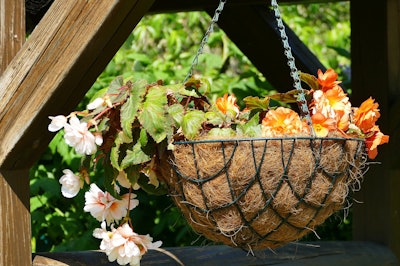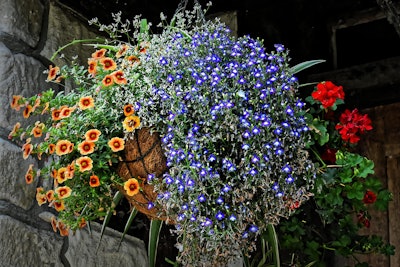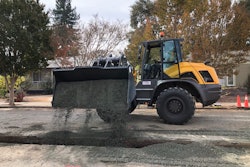 Photo: Pixabay
Photo: PixabayAlong with wanting their lawns to look pristine this season, customers are also looking for enticing features to add to their patios and porches.
Hanging baskets and container gardens give clients the eye-catching element they crave without having to create an entirely new flower bed. And for those that might live in smaller areas, utilizing these gardening methods could be the perfect solution for little to no excess plant space.
Check out a few tips to help you create beautiful hanging baskets or container gardens that your customers are sure to love.
Picking out pots and baskets
Plants won’t typically have a preference as to what kind of pot they are planted in, but the size and the ability of the pot to drain well are definitely aspects to keep an eye on.
For potted plants to truly flourish, they need to have room to grow, as well as containers that allow them to get rid of excess water when necessary.
Since there are numerous types of pots to choose from when it comes to shapes, sizes, colors, and materials, finding something that will suit your particular customer shouldn’t be a problem. However, each pot will require a different kind of upkeep, so be sure to choose something that fits well with your customer.
Keep in mind that it’s much easier to grow a plant in a larger pot than in a smaller one, so when in doubt about the size you’ll need, it’s not a bad idea to upsize. Larger pots are able to regulate temperatures better, hold more soil, retain moisture longer, and won’t require the plant to be transplanted once it begins growing.
Be sure to choose a container that allows optimum root growth, as the soil will quickly dry out and hinder the plant’s growth if it becomes rootbound.
For those living in areas with extreme heat this summer, it’s also good to remember that smaller hanging baskets will be more prone to drying out once that heat sets in. Darker containers will also not keep the soil as cool as lighter colors will, so be sure to place them accordingly in the space.
As you would before any project, take time to talk to your customer about what type of plants he/she would like, as this will help you determine appropriate sizes for containers and baskets ahead of time.
Knowing whether the plant will be annual or perennial, the size and shape of its root system, and its growth rate will be beneficial to you as you decide on the containers.
Filling them up
 Photo: Pixabay
Photo: PixabayWhen filling the containers or baskets, be sure and keep an eye on what kind of lighting each plant will need, as you don’t want to put two vastly different types into one pot.
The tried and true method of implementing the filler, thriller, and spiller is always a good way to create a focal point when it comes to baskets and containers. This layered look allows you the chance to add height and depth in a simple way, while also experimenting with varying color schemes within the same container.
When choosing plants for a hanging basket, don’t just focus on the ones that will hang and trail. For larger baskets, utilizing the mounding, spreading, and upright growing plants can add a more layered and exciting look, as well as effectively fill in the space. Although, be sure not to add in plants that will grow too tall, as you don’t want them to exceed your anchoring point.
To make these features appear fuller, consider baskets that also allow you the ability to plant along the bottom and sides. Most traditional hanging baskets focus on the spiller plants, but being able to add plants in the surrounding spaces of the basket creates a more rounded and whole look that also makes the basket virtually disappear.
No matter what size pot or basket you’re working with, remember that these plants will continue to grow, so don’t overstuff them in an attempt to make them immediately look fuller. In time, the plants will naturally fill in empty space, so assure customers that growth and fullness will come.
Basket and container care
Because hanging baskets can’t hold as much soil as a container, they will require more fertilizer. Adding in a slow-release fertilizer to the soil before planting can help with this.
During the hotter months of the season, the baskets will need to maintain uniform moisture, so talk with customers about establishing a routine watering schedule for their hanging baskets. Hanging baskets are also more exposed to and affected by the wind, which means they will dry out faster and will require more frequent watering.
Since container gardens require more frequent watering than traditional gardens, let customers know that they’ll need to check the top of the soil routinely. If it’s dry to the touch, advise them to go ahead and give the plants a good soak.
Routine fertilization is also key to keeping container gardens thriving. There are many types of potting soil that already have a fertilizer element added in, but it’s still beneficial to add in just a bit of liquid fertilizer when watering.
When placing containers and baskets in your customer’s yard, make note of sunny and shaded spots, and take into consideration the water and fertilizer needs of the plants before deciding on a final spot.












